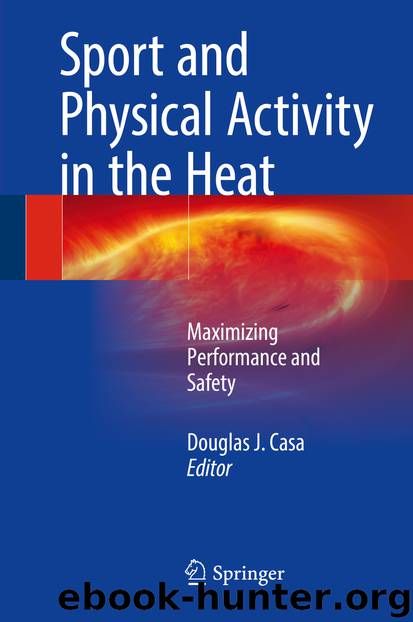Sport and Physical Activity in the Heat by Douglas J. Casa

Author:Douglas J. Casa
Language: eng
Format: epub
Publisher: Springer International Publishing, Cham
The Application
While GPS devices have enormous potential for monitoring athlete performance and risk of injury, organizations must be aware of the substantial commitments necessary to successfully integrate this technology into practical use. First and foremost, the GPS systems used to track competitive athletes require a substantial financial investment, typically between $500 and 5000 per unit. In addition, personnel must be available for all data collections and not only proficient in handling and troubleshooting the GPS hardware but also capable of organizing, cleaning, analyzing, and reporting GPS data. The following section provides a general overview of the steps required in order to utilize GPS data.
At least 10 min prior to data collection, all GPS devices should be turned outdoors to allow for proper synchronization with satellite signals. As measurements can vary between devices, each athlete should be assigned the same GPS device at each data collection. Users should also record important details of the data collection such as attendance, device issues, and the sequence of exercises performed. Following data collection, all GPS devices should be gathered so that data can be extracted and uploaded to a computer or data storage system promptly.
After data has been uploaded, the next challenge is to reduce the massive amounts of data that has been collected into more reasonable quantities. Tracking 11 players over the course of a single 90-min match with 10-Hz GPS devices will result in the collection of approximately 594,000 data points. Over 100 million data points may be collected if a season’s worth of training sessions and matches are recorded from an entire team.
Users should ensure and evaluate the quality of GPS data before data analysis begins. This includes examining the raw data for any irregularities (e.g., rapid spikes in the velocity trace) and assessing signal quality metrics such as the number of satellites interacting with each device. Although no gold standard criteria have been established, a recent review recommended that devices should be interacting with at least six satellites to ensure quality data [92]. All poor-quality data should be excluded and replaced to ensure that analysis and interpretation are not distorted.
In-depth analysis can be conducted on the GPS data collected during a single match or training session from individual athletes. To illustrate, Fig. 10.6 displays the movement velocities of two different soccer players (Player A and Player B) over the first half of a soccer match. Notably, Player A has a much lower max velocity than Player B (5.8 m·s−1 vs. 8.5 m·s−1). Interestingly, Player A had a higher average velocity over the half than Player B (2.0 m·s−1 vs. 1.6 m·s−1) and covered a greater overall distance (5394 m vs. 4343 m). Greater insight can be obtained by assessing the time spent in three velocity zones (Low, 0–3 m·s−1; Moderate, 3–6 m·s−1; High, 6+ m·s−1). For instance, it can be determined that Player B spent more time than Player A at both low velocities (38 min vs. 34 min) and high velocities (1 min vs. 0 min). In contrast, Player A spent a much greater time at moderate velocity than Player B (11 min vs.
Download
This site does not store any files on its server. We only index and link to content provided by other sites. Please contact the content providers to delete copyright contents if any and email us, we'll remove relevant links or contents immediately.
Periodization Training for Sports by Tudor Bompa(8097)
Why We Sleep: Unlocking the Power of Sleep and Dreams by Matthew Walker(6557)
Paper Towns by Green John(5024)
The Immortal Life of Henrietta Lacks by Rebecca Skloot(4447)
The Sports Rules Book by Human Kinetics(4213)
Dynamic Alignment Through Imagery by Eric Franklin(4050)
ACSM's Complete Guide to Fitness & Health by ACSM(3938)
Kaplan MCAT Organic Chemistry Review: Created for MCAT 2015 (Kaplan Test Prep) by Kaplan(3906)
Introduction to Kinesiology by Shirl J. Hoffman(3699)
Livewired by David Eagleman(3624)
The River of Consciousness by Oliver Sacks(3498)
The Death of the Heart by Elizabeth Bowen(3483)
Alchemy and Alchemists by C. J. S. Thompson(3422)
Bad Pharma by Ben Goldacre(3208)
Descartes' Error by Antonio Damasio(3188)
The Emperor of All Maladies: A Biography of Cancer by Siddhartha Mukherjee(3026)
The Gene: An Intimate History by Siddhartha Mukherjee(3014)
The Fate of Rome: Climate, Disease, and the End of an Empire (The Princeton History of the Ancient World) by Kyle Harper(2975)
Kaplan MCAT Behavioral Sciences Review: Created for MCAT 2015 (Kaplan Test Prep) by Kaplan(2903)
